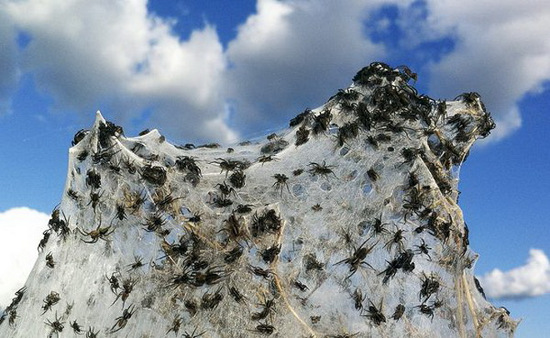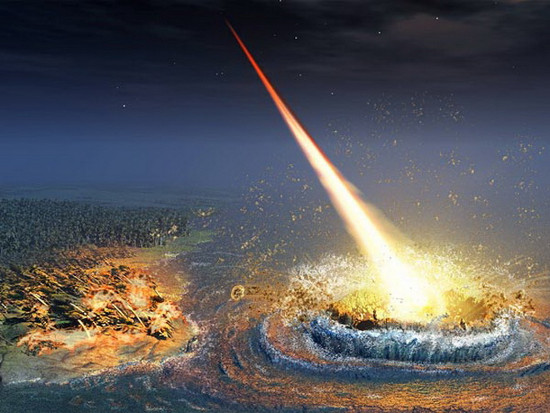10 most viewed scientific photos in 2012
National Geographic Magazine (USA) has just introduced the top 10 most viewed scientific photos in 2012, including the world's smallest picture of chameleon, white spotted spider images .
Please introduce yourself to read the top 10 images (ranked from bottom to bottom):
10. The 'vampire' skeleton

A 700-year-old 'vampire' skeleton is pierced through the chest by an iron bar - buried in the church ruins in the town of Sozopol on the Black Sea coast of southern Bulgaria - excavated by archaeologists and is on display at the National Museum of Natural History since June 2012.
According to the custom in the Middle Ages, people who were considered bad after death would be pierced through their chests with an iron bar so that they could not become 'vampires'.
9. Spiders spread the floodplain

Like a nightmare, spiders spread silk covered with plants when floods devastated a large area near the city of Wagga Wagga, New South Wales (Australia). In March 2012, after nearly a week of record rain, rising floodwaters flooded eastern Australia, forcing at least 13,000 people to leave their homes and make the spiders migrate from the ground massively.
8. NASA insists there is no apocalypse in the Mayan calendar

Apocalypse was rumored to be on December 21, 2012 according to the Mayan ancient calendar. Some of the apocalyptic prophecies that Earth will change polarity in 2012, Earth will be hit by an asteroid, the black hole will swallow Earth or the Sun's explosion: harmful radiation can destroy all life on Earth. But recent studies by the US Aerospace Agency (NASA) claim that no such thing has happened and there will be no collision between Earth and another planet.
7. The beach glows

In a study in March 2012, Harvard scientists (USA) explained the phenomenon of light waves at the beach on Vaadhoo Island in the Maldives Islands. Accordingly, bright blue seawater glows in the presence of creatures capable of luminescent with very high density in the country.
6. Solar Storms 'activate' aurora

The strongest aurora usually takes place after the mass eruption of the Sun. These bands of light constantly move and change, making them look like colored silk strips in the sky. In the picture is the Arctic light (Northern Aurora) is 'dancing' in the sky of the Lyngen Alps, Norway in January 2012. That brilliant aurora is generated by the interaction of charged particles from the solar wind with the planet's upper atmosphere.
5. 'Lost world' in Antarctica

Yeti swarms live around the hydrothermal vents with very hot temperatures at a depth of about 2.400m under the South Pole. In addition, in a report published in January 2012, scientists said that many new species, such as oysters, crabs, anemones and even octopuses, have been discovered completely in the dark.
4. Sharks eating bamboo sharks

In February 2012, Australian Center for Coral Reef Researchers (Australia) announced "snatching" the sight of carpet shark eating bamboo sharks at the Great Keppel Reef (coral reefs). The largest underground world The Great Barrier). This is a rare discovery because carpet sharks often hunt prey as invertebrates and small fish.
3. Monkeys specialize in nightlife

The nocturnal monkeys have a body weight of 0.9kg and a height of 0.3m, which was announced in September 2012. This is one of eight newly discovered mammal species in the Tabaconas Namballe National Reserve (Peru).
2. Footless amphibian species

For the first time, scientists discovered a new 'family' of footless amphibians, named Chikilidae, who lived under forested land in northeastern India. They are difficult to detect by living in the ground or under the carpet of fallen leaves in the forest. The amphibious 'mother' in the form of worms usually curls around the eggs, incubates the eggs, then the embryos form and grow in eggs for 2-3 months and then hatch directly into the baby. The above findings were published in February 2012.
1. The smallest chameleon in the world

In February 2012, scientists in Madagascar announced the discovery of a species of chameleon that is only about 2.9cm long, the body is only as big as a matchstick and fits on one's finger. They believe that this is one of the smallest reptiles in the world, scientifically named Brookesia micra.
- 18 strange and strange photos give you another view of the sea
- The endless beauty of Earth in a set of photos taken from the universe
- 5 scientific photos won prizes in 2005
- The wonders of the beautiful world when viewed from above
- The most unique scientific photo of 2013
- 10 most viewed scientific news in 2006
- Amazing earth images viewed from satellites
- The photos imagined photoshop but 100% real
- 10 most viewed science pictures in 2005
- World of 2008 viewed from satellites
- Absolute protection for your photos
- The most impressive scientific photos of 2015
 The 11 most unique public toilets in the world
The 11 most unique public toilets in the world Explore the ghost town in Namibia
Explore the ghost town in Namibia Rare historical moments are 'colored', giving us a clearer view of the past
Rare historical moments are 'colored', giving us a clearer view of the past The world famous ghost ship
The world famous ghost ship